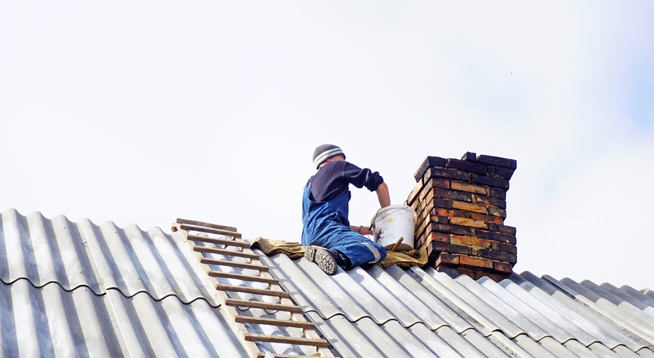
DETROIT, August 11, 2022 ~ Talk about “out of sight out of mind”! Who ever sticks their face in a chimney to conduct a visual inspection of the flue?
“The Guys” usually save this thinking for creepy places like crawl spaces or attics by suggesting at least an annual peek to make sure everything is sound and there are no uninvited critters in residence.
PODCASTS:
The Inside Outside Guys ~ August 14, 2022
But the Chimney Safety Institute of America (CSIA) tells us that 22,000 chimney fires are reported every year, and many more go unreported due to the simple fact that owners may not even be aware that a chimney fire occurred. The roughly $125 million dollars in damages caused by these fires could be eliminated or greatly reduced by proper and timely maintenance of chimneys and chimney flues.
Up until the 1960s, virtually every home in the country was built with a masonry chimney.
Initially, masonry chimneys were located in the center of the home, since heat in winter was such a valuable commodity that even the warmed brick chimney needed to be utilized to keep the home comfortable.
It was a luxury in the late 1940s and early ’50s to install a chimney on an outside wall of the home.
Most of those masonry chimneys had two to three flues to accommodate a furnace and, potentially, multiple fireplaces. A basic chimney consisted of tightly sealed and stacked clay flue tile where the exhaust gases travel from the heat source to outside air, an air space surrounding it, and a brick or stone chase that ran from the top of the supporting footing to several feet above the roof line.
In the past several decades, homes have been constructed with metal chimneys enclosed in a wood framed chase. These are far less costly to construct than the conventional masonry chimneys, but they can experience the same issues.
Chimneys require hot air to provide complete exhaust of the gases and particulate they carry. Specific ratios between a chimney cross section and the fireplace opening or furnace it is serving exist to assure good air flow.
If the air in a chimney begins to cool before it is exhausted, carbon-based particulate and corrosive moisture can accumulate on the flue walls. These materials can not only cause deterioration of the flue, but they can also become a source of fuel for a fire to occur inside the chimney.
We saw an uptick in chimney fires in the ’70s and ’80s eighties when homeowners retrofitted high efficiency wood burning stoves and fireboxes to large chimneys meant to service a standard fireplace.
Over time and use, flue tiles may settle or become cracked. The mortar joints between them may crack and disintegrate. These cracks may allow flames from a chimney fire to catch the surrounding house frame on fire.
The use of high efficiency furnace and water heaters that utilize forced exhaust have made masonry chimneys for these appliances obsolete.
But for those homes still using a chimney to exhaust a fireplace or other appliance annual cleaning and, in some cases, re-lining, and even downsizing, of the flues is a priority.
Additionally, the brick or stone enclosure can deteriorate and cause mortar joints to fail and brick or stone to delaminate or simply fall off the enclosure.
Inspection and cleaning might be conducted by a CSIA Certified Chimney Sweep. But re-lining of the flues requires a professional experienced in the various types of repairs available.
A joint repair system might be used in a chimney where only the mortar joints between tiles need repair whereas a resurfacing system would be used to repair both defective joints and minor defects in the clay tiles.
The ultimate repair is a re-lining that utilizes ceramic insulation reinforced with stainless steel fabric sandwiched between two coats of a Cerfractory Flue Sealant.
As you might expect, “The Guys” have a professional you can trust to service this need. Brickworks Property Restoration in Clinton Township can handle any type of masonry or concrete need you may have, whether for a new installation or repair of an existing problem.
Take a look at your chimney or, better yet, have one of the professionals at InsideOutsideGuys.com inspect it for you.
For housing advice and more, listen to “The Inside Outside Guys” every Saturday and Sunday on 760 WJR, from 10 a.m. to noon or contact us at InsideOutsideGuys.com.
WJR TOP STORIES:

